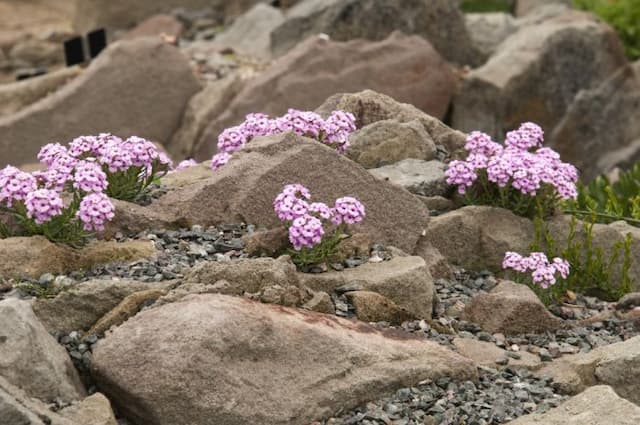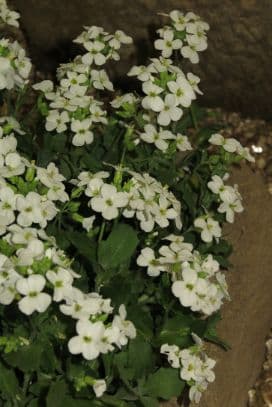Kitaibel's Bittercress Cardamine kitaibelii

ABOUT
Cardamine kitaibelii, commonly known as Kitaibel's bittercress, is a flowering plant that exhibits a basal rosette of leaves from which stems arise. The leaves are typically pinnate, which means they have a central stem with smaller leaflets arranged on either side. These leaflets are generally oval to oblong in shape, with the possibility of being slightly serrated or having rounded teeth along the edges. The plant produces delicate flowers on erect stems that stand clear of the basal leaves. The flowers are usually small and characterized by four pale pink to white petals that form a cross shape, a distinctive feature of many members of its family. At the center of the flower, one can usually see a cluster of stamens and pistils. The fruit of Kitaibel's bittercress follows the flowers, typically presenting as elongated, narrow pods known as siliques. These pods split open when mature to release the seeds contained within. The overall appearance of the plant is simplistic yet charming, with its modest blooms and fresh green foliage lending it an unassuming beauty. It can often be found gracing moist areas with its presence.
About this plant
 Names
NamesFamily
Brassicaceae
Synonyms
Kitaibel's Bittercress, Kitaibel's Cardamine
Common names
Dentaria glandulosa, Cardamine glandulosa
 Toxicity
ToxicityTo humans
Cardamine kitaibelii, commonly known as Kitaibela's bittercress, is not widely reported as a toxic plant to humans. However, as with any plant that is not commonly consumed or recognized as edible, caution should be exercised. If a plant is not specifically known to be safe for ingestion, it is generally advised to avoid eating it due to potential unknown toxic compounds that could cause adverse reactions.
To pets
For pets, the toxicity of Kitaibela's bittercress, or Cardamine kitaibelii, is similarly not well documented. Without specific reports or studies on its effects on pets, it is prudent to prevent pets from ingesting this plant. In general, if a pet does consume a plant of uncertain edibility, it would be wise to monitor for any signs of illness and consult with a veterinarian as necessary.
 Characteristics
CharacteristicsLife cycle
Biennials
Foliage type
Deciduous
Color of leaves
Green
Flower color
White
Height
1 foot 8 inches (50 cm)
Spread
0 foot 8 inches (20 cm)
Plant type
Herb
Hardiness zones
5
Native area
Europe
Benefits
 General Benefits
General Benefits- Ecosystem Support: Cardamine kitaibelii, commonly known as Kitaibel's Bittercress, plays a role in natural ecosystems by providing food for various insects and serving as a host for butterfly larvae.
- Soil Stabilization: Kitaibel's Bittercress can help prevent soil erosion due to its root system that anchors soil in place.
- Biodiversity Contribution: As a native species, Cardamine kitaibelii contributes to the biodiversity of its habitat, offering genetic variation that can be crucial for ecosystem resilience.
- Aesthetic Appeal: Kitaibel's Bittercress, with its delicate flowers, can enhance the natural beauty of an area, contributing to the aesthetic value of wild landscapes and gardens.
- Scientific Research: Cardamine kitaibelii can be of interest to botanical research due to its specific adaptations and characteristics, contributing to our understanding of plant biology and ecology.
- Pollinator Attraction: The flowers of Kitaibel's Bittercress attract bees and other pollinators, playing an essential role in the pollination process of various plants and contributing to overall plant biodiversity.
- Education and Awareness: This species can be used for educational purposes to raise awareness about plant conservation and the importance of preserving local flora.
- Cultural Significance: In some regions, native plants like Kitaibel's Bittercress may have historical or cultural significance, which can be important for preserving cultural heritage.
- Wildlife Nourishment: The seeds and foliage of Kitaibel's Bittercress can provide nourishment for wildlife, including birds and small mammals.
- Ecosystem Indicator: As a native species, the presence and health of Cardamine kitaibelii populations can serve as an indicator of ecosystem health and integrity.
 Medical Properties
Medical PropertiesThis plant is not used for medical purposes.
 Air-purifying Qualities
Air-purifying QualitiesThis plant is not specifically known for air purifying qualities.
 Other Uses
Other Uses- Cardamine kitaibelii, commonly known as the Kitaibel's bittercress, can be used as a natural dye for fabrics, yielding various hues depending on the mordant used.
- In some regions, Kitaibel's bittercress is used to create vivid and non-toxic watercolors for artistic purposes.
- The leaves of the plant, due to their decorative appearance, are occasionally pressed and used in botanical artwork or herbarium collections.
- Kitaibel's bittercress may serve as an indicator species in certain ecosystems, suggesting specific soil or moisture conditions.
- Some cultures have used the seed pods of Kitaibel's bittercress in traditional children's games, much like mini poppers, due to their explosive dehiscence when ripe.
- The plant is sometimes cultivated in domestic gardens as part of a wildflower meadow to support biodiversity.
- Enthusiasts of miniature plant sculptures may use Kitaibel's bittercress to create small-scale green arrangements due to its delicate structure.
- Fine chefs might use the small flowers of Kitaibel's bittercress to garnish gourmet dishes, adding a touch of elegance and subtle flavor.
- In craft making, the tiny seeds can be used to create homemade natural jewelry or eco-friendly decorative items.
- Educational purposes, such as studying the life cycle of plants or the process of pollination, often include Kitaibel's bittercress because of its distinct characteristics.
Interesting Facts
 Feng Shui
Feng ShuiThe Cardamine kitaibelii is not used in Feng Shui practice.
 Zodiac Sign Compitability
Zodiac Sign CompitabilityThe Cardamine kitaibelii is not used in astrology practice.
 Plant Symbolism
Plant Symbolism- Rarity - Cardamine kitaibelii, commonly known as Kitaibel's Bittercress, is a rare plant, symbolizing the uniqueness and preciousness of scarce things in nature and in personal life.
- Beauty in Simplicity - Despite its unassuming appearance, Kitaibel's Bittercress represents the idea that there's beauty in simplicity and that even the smallest plants can have aesthetic value.
- Adaptability - This plant's ability to thrive in specific habitats suggests the symbolic meaning of adaptability to life's circumstances.
- Spring Awakening - As a spring ephemeral, Kitaibel's Bittercress symbolizes new beginnings and the awakening of nature after winter's sleep, reflecting rebirth and renewal.
- Discreet Presence - Given its tendency to go unnoticed, it symbolizes a discreet presence and the idea that not everything that is important is always in the spotlight.
 Water
WaterFor the Cardamine kitaibelii, commonly known as Kitaibel's bittercress, water the plant when the top inch of soil feels dry to the touch, which might be roughly once a week, depending on environmental conditions. Use room temperature water and gently soak the soil around the plant until it begins to drain from the bottom of the pot. This plant does not tolerate standing water, so ensure that any excess is removed to prevent root rot. It's estimated you might need about 8 to 16 ounces of water per watering session, but always adjust depending on the plant's response and the season, watering more during active growth in spring and summer, and reducing in fall and winter.
 Light
LightKitaibel's bittercress thrives in partial to full shade, avoiding direct sunlight which can scorch its leaves. The best spot for this plant would be in a north-facing window or a location that receives filtered light throughout the day. Ensuring consistent light but protecting it from intense direct sun will keep the Kitaibel's bittercress healthy.
 Temperature
TemperatureKitaibel's bittercress prefers cool to moderate temperatures, ideally between 50°F and 70°F. It can survive in temperatures as low as 40°F but should be protected from frost. Avoid placing Kitaibel's bittercress near heat sources or in locations where temperatures fluctuate widely, which can stress the plant.
 Pruning
PruningPruning Kitaibel's bittercress is typically done to maintain its shape or remove any yellowing or dead leaves to encourage healthy growth. Prune the plant lightly as needed throughout the growing season, making clean cuts with sterilized scissors to prevent disease. The best time for more extensive pruning is in early spring before new growth begins.
 Cleaning
CleaningAs needed
 Soil
SoilKitaibel's bittercress prefers a well-draining soil mix, high in organic matter, with a slightly acidic to neutral pH of 6.0 to 7.0 for optimal growth. A mix of loam, peat, and sand in equal parts can provide the right structure and fertility.
 Repotting
RepottingKitaibel's bittercress does not generally require frequent repotting; it can be repotted every 2-3 years or as needed if the plant outgrows its container.
 Humidity & Misting
Humidity & MistingKitaibel's bittercress thrives best in moderate to high humidity levels, ideally between 60-75% to mimic its natural habitat conditions.
 Suitable locations
Suitable locationsIndoor
Place Kitaibel's bittercress in bright, indirect light and maintain humidity.
Outdoor
Keep in partial shade, protect from harsh sun and extreme cold.
Hardiness zone
4-8 USDA
 Life cycle
Life cycleCardamine kitaibelii, commonly known as Kitaibel's bittercress, begins its life as a seed, which upon germination gives rise to a small seedling with cotyledons (seed leaves). As the seedling matures, it develops true leaves and a root system, transitioning into a vegetative growth phase. This perennial herbaceous plant will continue to grow and can spread through rhizomes if conditions are suitable. The next phase is the flowering stage, where Kitaibel's bittercress produces small white flowers, which are typically pollinated by insects, leading to cross-fertilization. After successful pollination, the plant forms seed pods (silique) which mature and eventually release seeds, completing the reproductive cycle. The life cycle may vary with environmental conditions, but these stages are central to the perennial lifecycle of Kitaibel's bittercress.
 Propogation
PropogationPropogation time
Spring-early summer
Cardamine kitaibelii, commonly known as Kitaibel's bittercress, is typically propagated through seed. To achieve successful propagation, seeds should be collected after the pods mature and begin to dry on the plant. Sowing can be done either in autumn or spring. When sowing in spring, it might be beneficial to stratify seeds in the refrigerator for several weeks to simulate winter conditions, which can enhance germination. Once sown, the seeds should be lightly covered with soil and kept moist until germination occurs. Germination can vary but typically takes place within a couple of weeks to a couple of months, depending on conditions. Seedlings can then be carefully transplanted to their desired location once they've developed a few true leaves and are large enough to handle.



![Aubrieta [Axcent Light Blue]](/_next/image?url=https%3A%2F%2Fplants-admin.emdemapps.com%2Fimages%2Fplants%2F%2Fimages%2F604b5e7128866.png&w=640&q=75)





